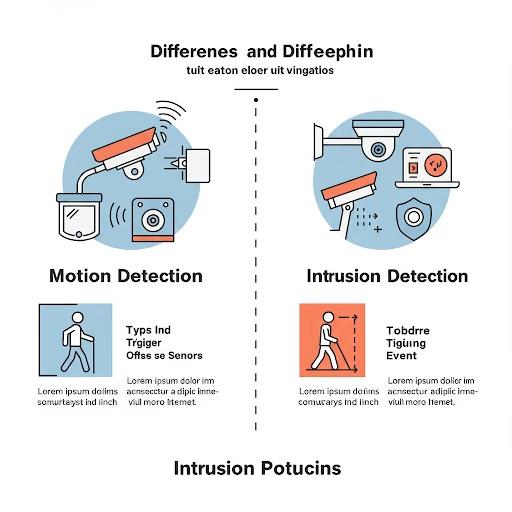Motion Detection vs Intrusion Detection:
Choosing the Right Security Camera
In the realm of security cameras, two features frequently take center stage: motion detection and intrusion detection. While both aim to enhance security, they operate on distinct principles and cater to different needs. Understanding their nuances is crucial for selecting the right camera to safeguard your property.
Motion Detection: Sensing Any Movement
Motion detection, as the name suggests, is a feature that triggers an alert or recording when the camera detects any movement within its field of view. This movement can stem from various sources, including people, animals, vehicles, or even changes in lighting.
- How it Works:
- Motion detection algorithms analyze changes in pixels within the camera’s view. When a significant alteration occurs, indicating movement, the system activates.
- Sensitivity levels can often be adjusted, allowing users to fine-tune the system to minimize false alarms.
- Applications:
- Motion detection is versatile, suitable for monitoring large areas like parking lots, warehouses, or expansive yards.
- It’s valuable for capturing general activity, providing a record of events that transpire within the camera’s range.
- Advantages:
- Versatility: Capable of detecting a wide range of movements.
- Ease of Use: Generally straightforward to set up and configure.
- Disadvantages:
- False Alarms: Susceptible to triggers from non-threatening movements, such as swaying branches or passing animals.
- Lack of Precision: Doesn’t differentiate between various types of movement.
Intrusion Detection: Focused on Unauthorized Entry
Intrusion detection, in contrast, is more specific, designed to detect unauthorized entry into designated areas. This feature is particularly valuable for safeguarding sensitive zones.
- How it Works:
- Intrusion detection allows users to define specific zones within the camera’s view.
- The system triggers an alert only when an object crosses the boundaries of these defined zones.
- Advanced systems may incorporate AI to distinguish between humans and other objects, minimizing false alarms.
- Applications:
- Ideal for monitoring entry points like doors and windows, or protecting valuable assets within a specific area.
- Commonly used in high-security settings such as banks, museums, and residences.
- Advantages:
- Precision: Reduces false alarms by focusing on specific entry points.
- Enhanced Security: Provides targeted alerts for potential intrusions.
- Disadvantages:
- Limited Scope: Less effective for general surveillance of large areas.
- More Complex Setup: May require more intricate configuration than motion detection.
Choosing the Right Camera for Your Needs
The optimal choice between motion detection and intrusion detection depends on your specific security requirements. Here’s a breakdown to help you decide:
- For General Surveillance:
- If your primary goal is to monitor general activity across a wide area, a camera with motion detection is a suitable choice.
- For Enhanced Security:
- If your focus is on preventing unauthorized entry into specific areas, a camera with intrusion detection is essential.
- For Optimal Protection:
- Consider cameras that offer both features, providing a comprehensive security solution.
- Cameras with AI capabilities are becoming more common, and these greatly reduce false alarms.
Key Considerations:
- Camera Quality:
- Opt for cameras with high-resolution imaging for clear footage.
- Ensure the camera offers adequate night vision capabilities.
- Smart Features:
- Look for cameras with smart features like facial recognition and vehicle detection, which can enhance security.
- Many cameras now offer smart phone integration, so you can monitor your property from anywhere.
- Storage Options:
- Consider cloud storage or local storage options based on your needs.
- Environmental Factors:
- If the camera will be placed outdoors, ensure it is rated to withstand the elements.
In Conclusion
Motion detection and intrusion detection are valuable features in security cameras, each serving distinct purposes. By understanding their differences and considering your specific needs, you can select the right camera to ensure optimal security for your property.
Share this:
- Click to share on Facebook (Opens in new window) Facebook
- Click to share on X (Opens in new window) X
- Click to share on WhatsApp (Opens in new window) WhatsApp
- Click to email a link to a friend (Opens in new window) Email
- Click to share on Reddit (Opens in new window) Reddit
- Click to share on LinkedIn (Opens in new window) LinkedIn
- Click to share on Pinterest (Opens in new window) Pinterest
- Click to share on Telegram (Opens in new window) Telegram
Related
Discover more from ChenAnIoT
Subscribe to get the latest posts sent to your email.




